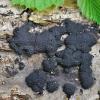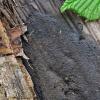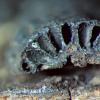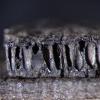
17-04-2015 13:29
Mario FilippaBonjour, j'ai trouvé ces deux fructification de

16-04-2015 09:19
 Blasco Rafael
Blasco Rafael
Hola, repito mensaje, ya que al estar mezclado con

02-04-2015 22:07
Me la mandan de GaliciaNo se por donde comenzarSal

16-04-2015 11:25
Garcia SusanaHello, I found these apothecia on wood probably s

15-04-2015 22:57
Quijada LuisHi all, somebody has the following manuscript:Kor

15-04-2015 16:48
Eduard OsieckCapronia with partly submuriform spores: 16-19 x 5

15-04-2015 17:38
Martin PastircakHi, I'm looking for the following one publicatio
j'ai trouvé ces deux fructification de Hypoxylon sur le même tronc sec de Corylus, une sur l'écorce (pulvinée confluente) et l'autre sur le bois décortiqué (étalée). Je pense que c'est la même espèce.
Il n'y a plus d'asques désormais, mais seulement quelques spores vides de 10-12x4-5 µm, brunes, avec fente d'une côté à l'autre.
Je n'espérais beaucoup de lui déterminer, mais ensuite j'ai vu les périthecies très hautes (1 mm ou plus). Hypoxylon macrocarpum peut-être?
Bonjour Mario,
Ce n'est pas impossible, même s'il manque des éléments.
As-tu senti le stroma (le brun) sur le frais ? Un bon signe pour H. macrocarpum est une agréable odeur aromatique, que j'ai identifié personnellement comme un mélange de vanille et noix de coco, mais les odeurs ce n'est pas évident.
Alain
PS le stroma noir pulviné me fait davantage penser à un très très vieux Annulohypoxylon multiforme, il peut y avoir deux espèces.

oui tu as raison H. macrocarpum ressemble bien à ça quand il est mort depuis longtemps. Il est toutefois plus facile à reconnaître quand il est vivant.
Amitiés,
Jacques
Did you already check the synoptic Hypoxylon key at:
http://pyrenomycetes.free.fr/hypoxylon/index.htm ?
However you should be sure that you are dealing with a (Annulo)Hypoxylon. Did you perform the KOH-test? Put a small piece of stroma in KOH (on a glass slide): if the fluid colours your pyrenomycete should be an Hypoxylon/ Anullohypoxylon. Note the colour it is important for identification. Anyway tubular perithecia are typical for H. macrocarpum.
Eduard
Merci beaucoup de vos avis.
Il n'a pas d'odeur (le bois aussi) mais il est très vieux, je pense que ce caractère n'est plus fiable désormais.
J'ai fait l'épreuve du KOH, le pigment est nettement vert d'abord, ensuite un peu plus brun mais toujours avec une nuance d'olive.
Pour les stromata pulvinés j'ai eu moi aussi, tout d'abord, l'idée de H. multiforme, que j'ai trouvé dans le même endroit sur Alnus la semaine passée, parfaitement mûr. Mais il avait des perithècies plus larges et rondes, des ostioles très proheminentes, et les spores avec une fente bien plus courte (il faut rappeler que ici je n'ai vu que des envelopes vides).
De toute façon il me suffirait d'identifier l'un des deux :)
Pyrenomycetes.free.fr c'est la première chose que je régarde quand j'ai un Hyopxylon...
Mario



